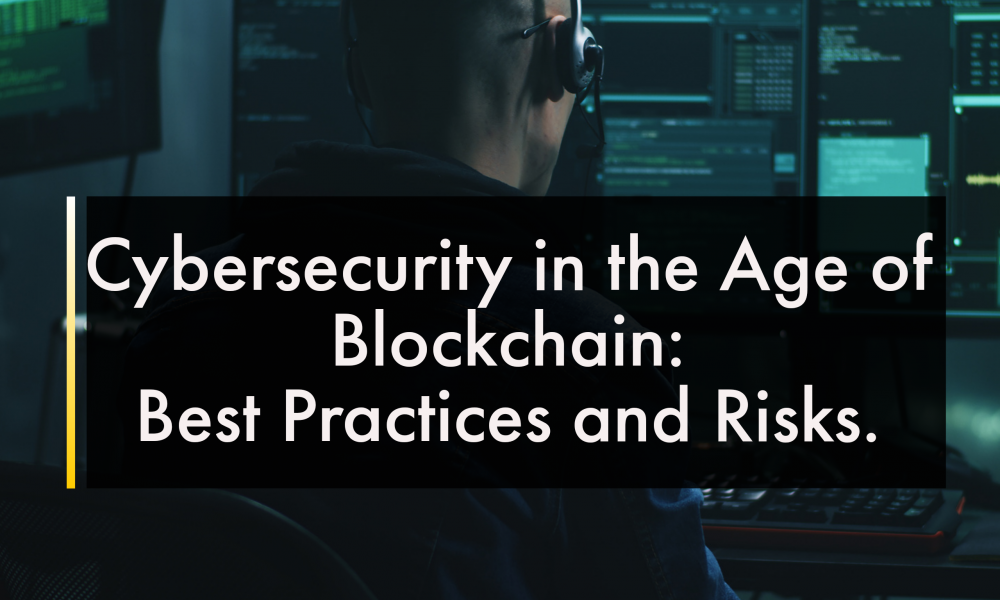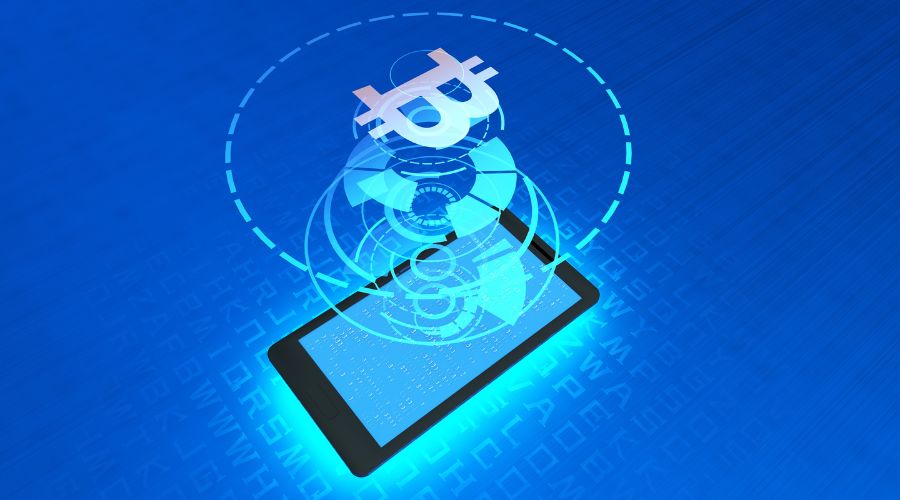Exploring cybersecurity risks and best practices in the blockchain age

[gpt3]rewrite
Blockchain technology has received significant attention in recent years due to its potential to revolutionize the way we see money, store money and exchange data. By providing a secure and decentralized platform for transactions, blockchain technology can help prevent fraud, reduce costs and increase transparency in a wide range of industries. However, as with any new technology, there are risks associated with its use, especially when it comes to cyber security.
In this article, we will explore the security benefits of blockchain technology, the cybersecurity risks associated with its use, and best practices for implementing strong cybersecurity measures in blockchain technology. We will also examine real-world examples of cybersecurity breaches involving blockchain technology and discuss the potential impact of new trends and technologies on blockchain cybersecurity.
The security benefits of Blockchain
Blockchain technology provides several important security benefits that make it an attractive platform for transactions. Perhaps the most important of these benefits is its ability to provide a tamper-proof and secure ledger of transactions. This is achieved through the use of cryptographic algorithms such as Hash functions, Merkle trees, digital signatures and public key cryptography that ensure the integrity of the data on the blockchain.
Each transaction on the blockchain is verified and validated by a network of nodes, which use complex algorithms to ensure that the transaction is valid and that the data on the blockchain has not been tampered with. Once a transaction is validated, it is added to the blockchain, creating a secure and immutable record of the transaction.
In addition to its tamper-proof nature, blockchain technology is also highly secure due to its decentralized nature. Because there is no central authority or control point, it is difficult for cybercriminals to compromise the security of the blockchain.
Cybersecurity risks related to blockchain
Although blockchain technology is highly secure, it is not invincible. There are several cybersecurity risks associated with the use of blockchain, including:
- Cyber attacks on blockchain networks:
Cybercriminals can target blockchain networks with attacks such as 51% attacks, denial of service (DoS) attacks, and phishing attacks. These attacks can compromise the security of the blockchain and lead to the theft of funds or manipulation of data.
For example, transactions on the Bitcoin network may be vulnerable to attacks, particularly attacks on transaction malleability. In this type of attack, an attacker modifies a transaction’s ID hash and broadcasts the modified transaction to the network. If the modified transaction is confirmed by miners before the original transaction, the sender’s account will be charged twice while they believe that the first transaction failed. In 2014, Mt. Gox, a Bitcoin exchange, bankrupt due to a malleability attack. To solve this problem, Bitcoin introduced the Segregated Witness process (SegWit) that separates signature data from Bitcoin transactions, replacing it with a non-malleable hash commitment.
Routing attacks are another type of cyberattack on blockchain networks that can affect both individual nodes and the entire network. The attacker can tamper with transactions before sending them to others, divide the network into separate groups that cannot communicate with each other, and delay the propagation of messages.
Then we have the key generation errors. In December 2014, a hacker known as Johoe was able to gain access to private keys provided by Blockchain.info by exploiting vulnerabilities in key generation. A code update led to poor randomization of inputs to generate user public keys, allowing the hacker to exploit this vulnerability. Although it was quickly fixed, the same error is still possible with the ECDSA algorithm.
2. Smart contract vulnerability
Smart contracts, which are self-executing contracts with the terms of the agreement written into code on the blockchain, can be vulnerable to code errors or mistakes. These vulnerabilities can be exploited by cybercriminals to steal funds or manipulate data.
In March 2021, Meerkat Finance, another DeFi project built on the BNB chain, suffered a hack that resulted in a loss of $31 million in cryptocurrencies. The attacker exploited a vulnerability in Meerkat Finance’s smart contract that allowed them to create unlimited amounts of the project’s original token, before exchanging it for other cryptocurrencies and withdrawing the funds.
3. Social engineering attacks:
Cybercriminals can use social engineering techniques to trick users into divulging their private keys or other sensitive information. This could lead to theft of funds or compromise of the blockchain network.
In July 2020, hackers took control of several high-profile Twitter accounts, including Elon Musk and Barack Obama, and used them to promote a Bitcoin scam. The attack was carried out by social engineers at Twitter to give the hackers access to internal systems and tools.
Then the next year, in 2021, a group of hackers used SIM swapping attacks to steal $100 million worth of cryptocurrencies from multiple victims. They used social engineering tactics to convince victims’ mobile operators to transfer control of their phone numbers to new SIM cards, allowing the hackers to bypass two-factor authentication and gain access to victims’ crypto wallets. Researchers also discovered several fake mobile apps on the Google Play Store and Apple App Store impersonating popular crypto wallets and exchanges. The apps were designed to steal users’ credentials and private keys, allowing attackers access to their crypto wallets.
Blockchain cybersecurity best practices
To mitigate these risks, it is important for organizations to implement strong cybersecurity measures when using blockchain technology. Some best practices include:
1. Multi-factor authentication: Requiring users to provide multiple forms of identification, such as a password and a fingerprint, can make it more difficult for cybercriminals to gain unauthorized access to the blockchain network.
2. Encryption: Encryption of data on the blockchain can make it more difficult for cybercriminals to gain access to sensitive information.
3. Regular vulnerability assessments: Regular assessment of the security of the blockchain network can help identify and mitigate vulnerabilities before they can be exploited by cybercriminals.
Case Studies of Blockchain Cybersecurity Breaches
In June 2016, the DAO, a decentralized autonomous organization built on the Ethereum blockchain, suffered a $50 million hack. The attacker was able to exploit a vulnerability in the organization’s smart contract code to siphon funds from the organization’s digital wallet. The hack eventually led to a contentious hard fork of the Ethereum blockchain, with some members of the community advocating for the return of the stolen funds and others arguing that it would set a dangerous precedent.
In September 2020, KuCoin, a cryptocurrency exchange, suffered a $280 million hack. The hackers were able to access the exchange’s hot wallets and steal various cryptocurrencies, including Bitcoin, Ethereum and Litecoin. However, the exchange was able to recover most of the stolen funds by cooperating with other exchanges and blockchain networks.
In April 2021, DeFi100, a decentralized finance platform, disappeared from the internet after its developers were accused of defrauding investors out of millions of dollars in cryptocurrency. The platform’s website and social media accounts were taken down and the developers behind the project went into hiding, leaving investors with no way to get their money back.
In the same year, in August 2021, the Poly Network, a decentralized financial platform, suffered a $600 million hack. The hacker was able to exploit a vulnerability in the platform’s smart contracts to steal cryptocurrencies from multiple blockchain networks. However, the hacker later returned the stolen funds, claiming it was an attempt to expose vulnerabilities in the platform’s security.
These case studies highlight the importance of strong cybersecurity measures in blockchain networks and the potential consequences of not adequately securing these systems.
These breaches highlight the importance of implementing strong cybersecurity measures when using blockchain technology. In response to these breaches, the blockchain community has developed new tools and technologies to improve the security of blockchain networks. For example, many blockchain networks now use multi-signature authentication, which requires multiple parties to sign a transaction before it can be executed. This makes it more difficult for cybercriminals to gain unauthorized access to the blockchain network.
New trends and technologies in Blockchain Cybersecurity
As blockchain technology continues to evolve, new trends and technologies are emerging that have the potential to improve the security of blockchain networks. One such technology is zero-knowledge proof, which allows users to prove the validity of a transaction without revealing any sensitive information. This can help protect the privacy of users on the blockchain while maintaining the integrity of the data on the network.
Another new trend in blockchain cybersecurity is the use of artificial intelligence and machine learning to detect and prevent cyber attacks. By analyzing large amounts of data, AI and machine learning algorithms can identify patterns and anomalies that may indicate a potential cyber attack. This can help organizations proactively identify and mitigate security threats on the blockchain network.
Conclusion
As with any new technology, it is important for organizations to carefully consider the risks and benefits of using blockchain technology, and implement appropriate security measures to protect against cyber attacks. By doing so, organizations can help ensure the security and integrity of their data on the blockchain network.
Also read; Understanding Ethereum Smart Contracts, dApps & Transactions
[gpt3]























